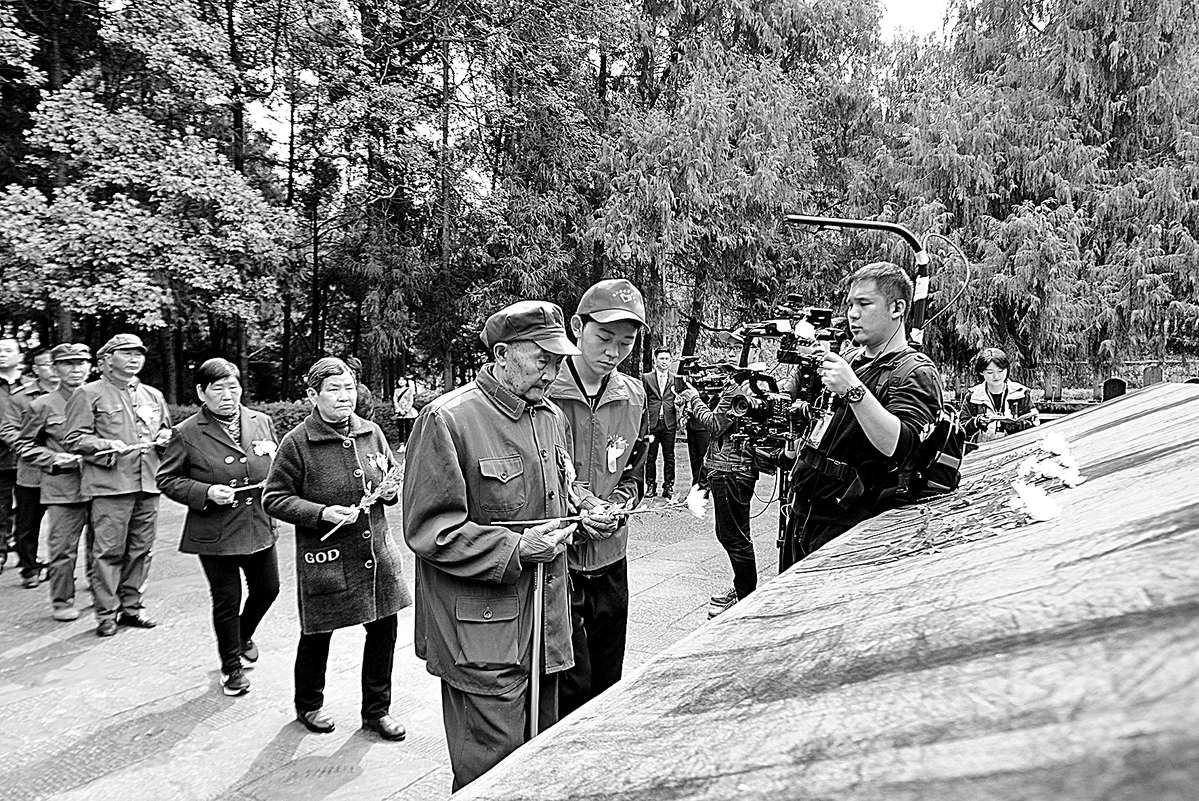Fourth Front Red Army struggled to protect Sichuan-Shaanxi base

Local people hold a memorial ceremony at the Sichuan-Shaanxi Revolutionary Base Martyrs' Cemetery, the country's largest for Red Army soldiers, in Bazhong, Sichuan province, in 2019. [Photo by Cheng Cong/for China Daily]
The Sichuan-Shaanxi Revolutionary Base, located on the border between the two provinces, was one of the most heavily populated Communist Party of China bases. Lasting for two and a half years, it was referred to as "a bridge linking Soviet revolutionary development between the northern and southern banks of the Yangtze River, and between northern and southern China" by Mao Zedong (1893-1976).
The Fourth Front Red Army set up the base and was its core military power. In the early 1930s, the army was developing the Hubei-Henan-Anhui Revolutionary Base in the Dabie Mountains, but after fending off three offensives by troops affiliated with the Kuomintang, or Chinese Nationalist Party, it took an overly optimistic approach to a fourth encirclement.
Trapped by fighting, the army was unable to defend the base and retreated westward in October 1932.
Under the guidance of Xu Xiangqian (1901-90), later one of 10 PLA marshals, the army conquered three counties in present-day northern Sichuan's Bazhong city and started to create a new revolutionary base in February 1933.
At the time, the army consisted of about 14,000 soldiers. Before warlords were able to organize a counterattack, the Red Army set up local Soviet governments and launched land redistribution campaigns. In mid-February, a provincial-level Soviet government was proclaimed.
According to Xu's memoir, despite the relatively low numbers of CPC members and limited spread of communist ideals, the area's poor farmers backed the Soviets, as they had suffered greatly at the hands of warlords and landlords.
The taxation of opium was a major source of revenue for warlords, and the prevalence of users damaged productivity and battle readiness. The local Soviets launched campaigns to encourage people to give up the drug.
Meanwhile, by absorbing local militia and training new soldiers, the Fourth Front Red Army expanded and began to prepare for battle.
They were able to take advantage of an internal conflict in the KMT that occurred when Sichuan warlords, fearing that KMT leader Chiang Kai-shek's (1887-1975) heavy involvement would diminish their interests in the province, attempted to take on the Red Army without external troops.
Tian Songyao (1888-1975) led the first major offensive against the base. After a four-month battle, the local warlord's offensive was smashed when the Red Army successfully lured Tian's troops into an ambush by faking a retreat.
Following their victory, the Red Army was able to launch three offensives before enemies had time to reorganize, and the base was expanded. According to the Sichuan-Shaanxi Revolutionary Base Museum, at its peak in late 1933, the base covered 42,000 square kilometers and was home to nearly 6 million people.
As agriculture, military production and industry flourished, it was able to support some 120,000 soldiers. Its success drew increased attention from the KMT and warlords. After mediating, Chiang placed Liu Xiang (1890-1938), one of the province's warlords and who later briefly became governor, in charge of defeating the Red Army. Liu launched a massive offensive in October 1933, with 250,000 soldiers attacking the base from six fronts.
Despite being heavily outnumbered, the Red Army resisted. After 10 months of fighting, it broke the siege and managed to retake most of the territory it had lost.
Victory came at a hefty price. Agricultural and industrial production was severely disrupted, and the KMT's continued economic blockade prevented the base from recovering.
Meanwhile, Chiang arrived in Xi'an in Shaanxi in October 1934 and personally planned a new siege, bringing in even more troops.
As prospects for defending the base darkened, it was eventually decided that the army's focus should be on breaking through the siege and on trying to develop new Red zones to the west on the borders between Sichuan, Shaanxi and Gansu provinces.
At about the same time, the Central Red Army, under the command of Mao Zedong following the Zunyi Conference in January 1935, began to march through Guizhou, Yunnan and Sichuan provinces.
To support the Central Red Army, the Fourth Front launched attacks on several counties in northern Sichuan and southern Shaanxi. Meanwhile, KMT forces encroached on the eastern part of the base.
In March, following a directive from the central leadership, the Fourth Front crossed the Jialing River and launched new westward offensives. Restocking on supplies captured during these offensives, it once again grew in size to about 80,000 soldiers.
After a few small-scale battles, the Fourth Front Red Army was able to successfully join forces with the Central Red Army in June in Maogong, in modern-day Sichuan, and later took part in the Long March. The Sichuan-Shaanxi base dissolved, and those that remained dedicated themselves to guerrilla warfare.

